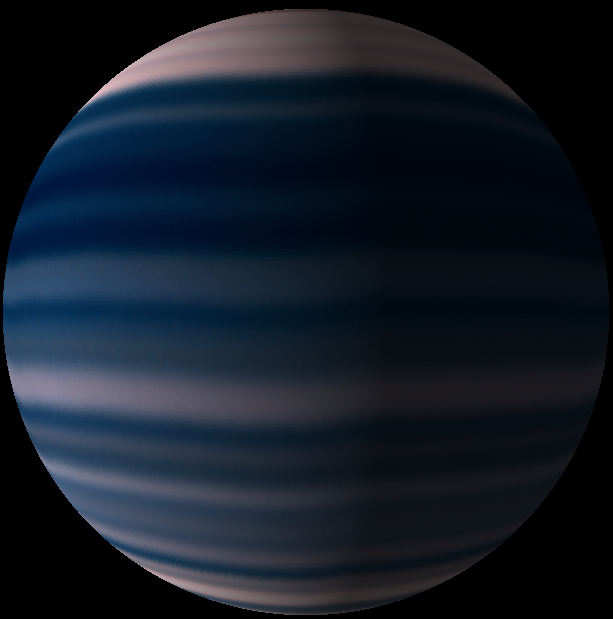|
Exoplanet Name : |
SOI-2 b |
|
Alternate Name : |
|
|
Status : |
Confirmed |
|
Radius (Rjup / Re): |
2.2200 |
(Rjup) |
24.8840 |
(Rearth) |
|
Mass (Mjup / Me): |
10.7248 |
(Mjup) |
3409.8100 |
(Mearth) |
|
Semi Major Axis / Orbital Distance Calculated |
0.0000 |
(AU) |
0.0285 |
(AU Est.) |
|
Eccentricity : |
0.5000 |
|
Orbital Period(Yrs) |
0.0057 |
|
Orbital Period(Observed/Estimated) |
2.10 |
(Days Obs.) |
0.00 |
(Days Est.) |
|
Surface Gravity (G Earth) |
5.5067 |
|
Star Radiation at Atmospheric Boundary: |
54177.0 |
(W/m2) |
|
Measured Temperature (K) |
0.0 |
(K) |
|
Blackbody T 0.1(K) |
680.9 |
(K) |
|
Blackbody T 0.3(K) |
639.5 |
(K) |
|
Blackbody T 0.7(K) |
517.4 |
(K) |
|
Tidally Locked Blackbody T 0.1(K) |
809.8 |
(K) |
|
Tidally Locked Blackbody T 0.3(K) |
760.4 |
(K) |
|
Size Class: |
Sub-Star-size |
|
Mass Class: |
|
|
Detection Type : |
Primary Transit |
|
Mass Detection : |
|
|
Radius Detection : |
Primary Transit |
|
Habitability by Solar Eq. Astronomical Unit: |
Not habitable |
|
Habitability by Kopparapu: |
Not habitable |
|
Star Name : |
SOI-2 |
|
Alternate Name : |
|
|
Star Distance(LY) : |
0.0 |
|
Stellar Radius(Rsun) : |
0.6 |
(Rsun Measured) |
|
Stellar Mass(Msun) : |
0.7 |
(Msun Measured) |
0.7 |
(Msun Estimated) |
|
Star Age : |
0.0 |
(GY) |
|
Temperature : |
3300 |
(K) |
|
Spectral type : |
M9 |
|
UV portion[%]: |
0.2 |
|
Visible portion[%]: |
11.2 |
|
IR portion[%]: |
88.6 |
|
Metalicity : |
0.0 |
|
Absolute Magnitude: |
25.0 |
|
Apparent Magnitude: |
22.0 |
|
Right Ascension(RA) |
3.1292 |
|
Declination (DEC) |
50.4558 |
|
Hubble Space Telescope Guide Star Catalog (GSC) ID |
|
|
Discovered by |
|
|
Discovery Paper - Authors |
|
|
Discovery Paper - Title |
|
|
Discovery Paper - Journal |
|
|
Discovery Paper - URL |
|
|
SIMBAD LINK |
|
|
Open Exoplanet Database Link |
|
 |
 |
 |
 |
/
SOI-2 b
SOI-2 b
SOI-2 b is an exoplanet orbiting the star SOI-2. Its discovery was publicly announced on 2023.
The host star SOI-2 has apparent magnitude of 22.0, with absolute magnitude of 25.0. It is 0.7 times more massive and 0.6 times bigger compared with our Sun. The surface temperature is 3300 with its spectral types of M9
In this planetary system, the extrasolar planet SOI-2 b orbits around the star SOI-2 every 2.1 days with its orbital distance of 0.03 AU ( 4262955.6 km)
(Projected orbit of SOI-2 b around its host star SOI-2)

The Star SOI-2 's habitable zone is located at the following distance
Inner Boundary (the orbital distance at Venus's Equivalent Radiation )
: 0.130 AU ( 19411034.5 km)
Earth Boundary (the orbital distance at Earth's Equivalent Radiation)
: 0.179 AU ( 26831122.4 km)
Outer Boundary (the orbital distance at Mars's Equivalent Radiation)
: 0.273 AU ( 40884692.8 km)
Snow Line (the orbital distance at Snow Line Equivalent Radiation)
: 0.402 AU ( 60163616.5 km)
Radiation at Planetary Boundary of SOI-2 b : 54177.03 W/m2
(Habitable zone calculated based on SEAU(Solar Equivalent Astronomical Unit) around the star SOI-2)

Kopparapu Recent Venus for Star SOI-2 distance : 0.147 AU
Kopparapu Runaway Greenhouse for Earth-sized planet for Star SOI-2 distance : 0.186 AU
Kopparapu Runaway Greenhouse for Super-Earth-sized planet for Star SOI-2 distance : 0.180 AU
Kopparapu Runaway Greenhouse for Mars-sized planet for Star SOI-2 distance : 0.198 AU
Kopparapu Outer Boundary for Maximum Greenhouse for Star SOI-2 distance : 0.365 AU
Kopparapu Outer Boundary for Early Mars for Star SOI-2 distance : 0.385 AU
(Habitable zone calculated based on Kopparapu et al.(2013) around the star SOI-2)

Original Kopparapu Recent Venus for Star SOI-2 distance : 0.146 AU
Original Kopparapu Runaway Greenhouse for Star SOI-2 distance : 0.193 AU
Original Kopparapu Moist Greenhouse for Star SOI-2 distance : 0.193 AU
Original Kopparapu Outer Boundary for Maximum Greenhouse for Star SOI-2 distance : 0.371 AU
Original Kopparapu Outer Boundary for Early Mars for Star SOI-2 distance : 0.386 AU
(Habitable zone calculated based on Kopparapu et al.(Original) around the star SOI-2)

(Position in Stellar Map of star SOI-2 and its Exoplanet SOI-2 b)

(Zoomed position in Stellar Map of star SOI-2 and its Exoplanet SOI-2 b (zoom level 3))

(Synthetic Spectrum of star SOI-2*)

*Yamashiki YA et al. 2019 ApJ 881 114
MUSCLES Paper I - France et al. 2016 ApJ 820 89
MUSCLES Paper II- Youngblood et al. 2016 ApJ 824 101
MUSCLES Paper III- Loyd et al. 2016 ApJ 824 102

